Medication Safety in Healthcare: QUM Strategies & Error Reduction
VerifiedAdded on 2022/08/21
|11
|1194
|13
Report
AI Summary
This report focuses on Quality Use of Medicines (QUM) and strategies to reduce medication errors within healthcare settings. It begins with an overview of QUM, its origins in the National Medicines Policy, and its patient-centered approach to ensuring the judicious, appropriate, safe, and efficacious use of medications. The report highlights the risks associated with medication errors, including increased healthcare costs, morbidity, and mortality, and identifies common causes such as lack of patient knowledge and poor healthcare practices. It emphasizes the importance of adhering to the National Safety and Quality Health Service Standard 4: Medication Safety and explores various strategies to mitigate errors. These include thorough patient assessments, continuous monitoring of treatment outcomes, patient education, medication reconciliation, and the use of computerized systems for clinical warnings. The report references key sources and provides a comprehensive overview of medication safety in healthcare.
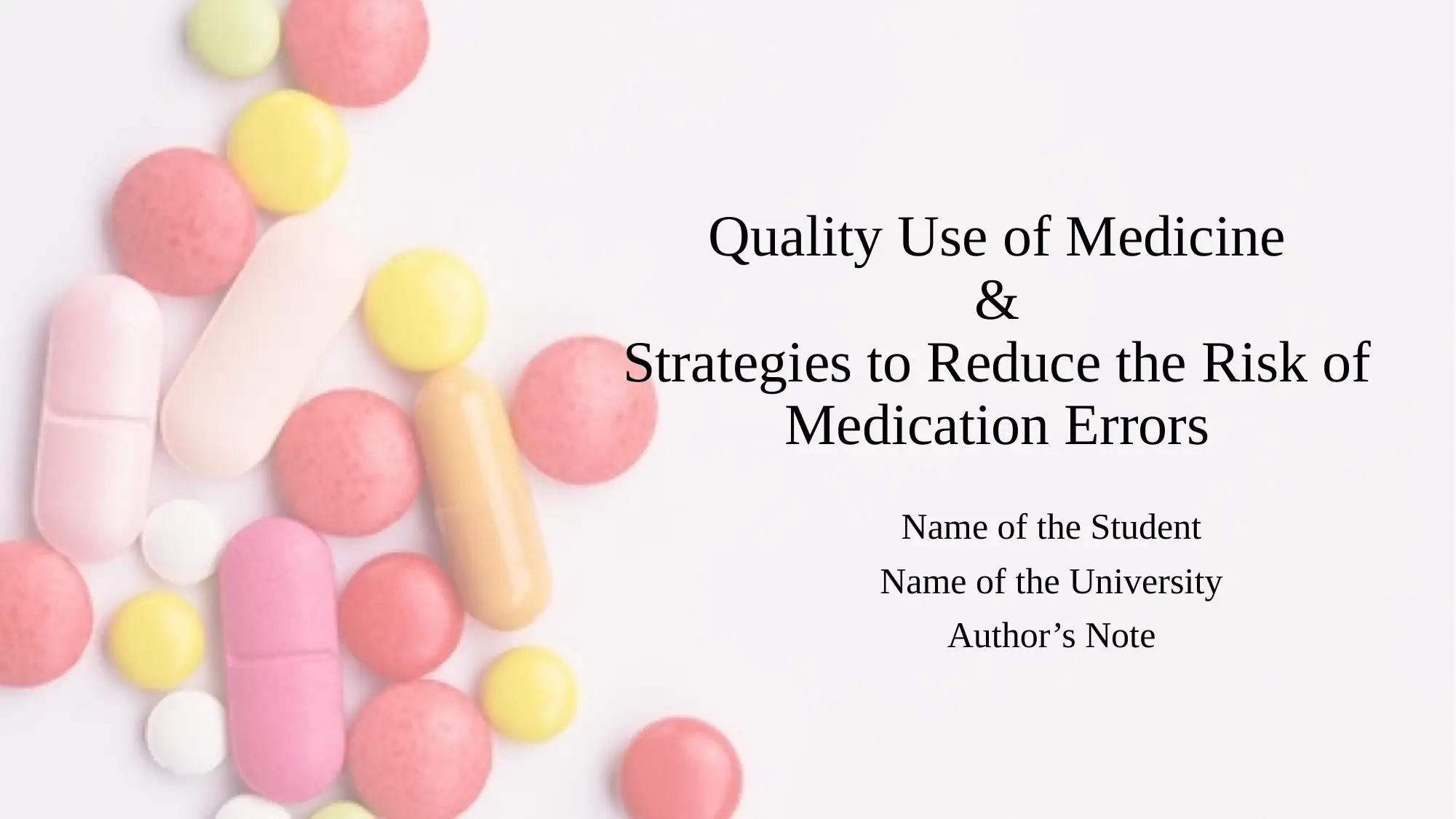
Quality Use of Medicine
&
Strategies to Reduce the Risk of
Medication Errors
Name of the Student
Name of the University
Author’s Note
&
Strategies to Reduce the Risk of
Medication Errors
Name of the Student
Name of the University
Author’s Note
Paraphrase This Document
Need a fresh take? Get an instant paraphrase of this document with our AI Paraphraser
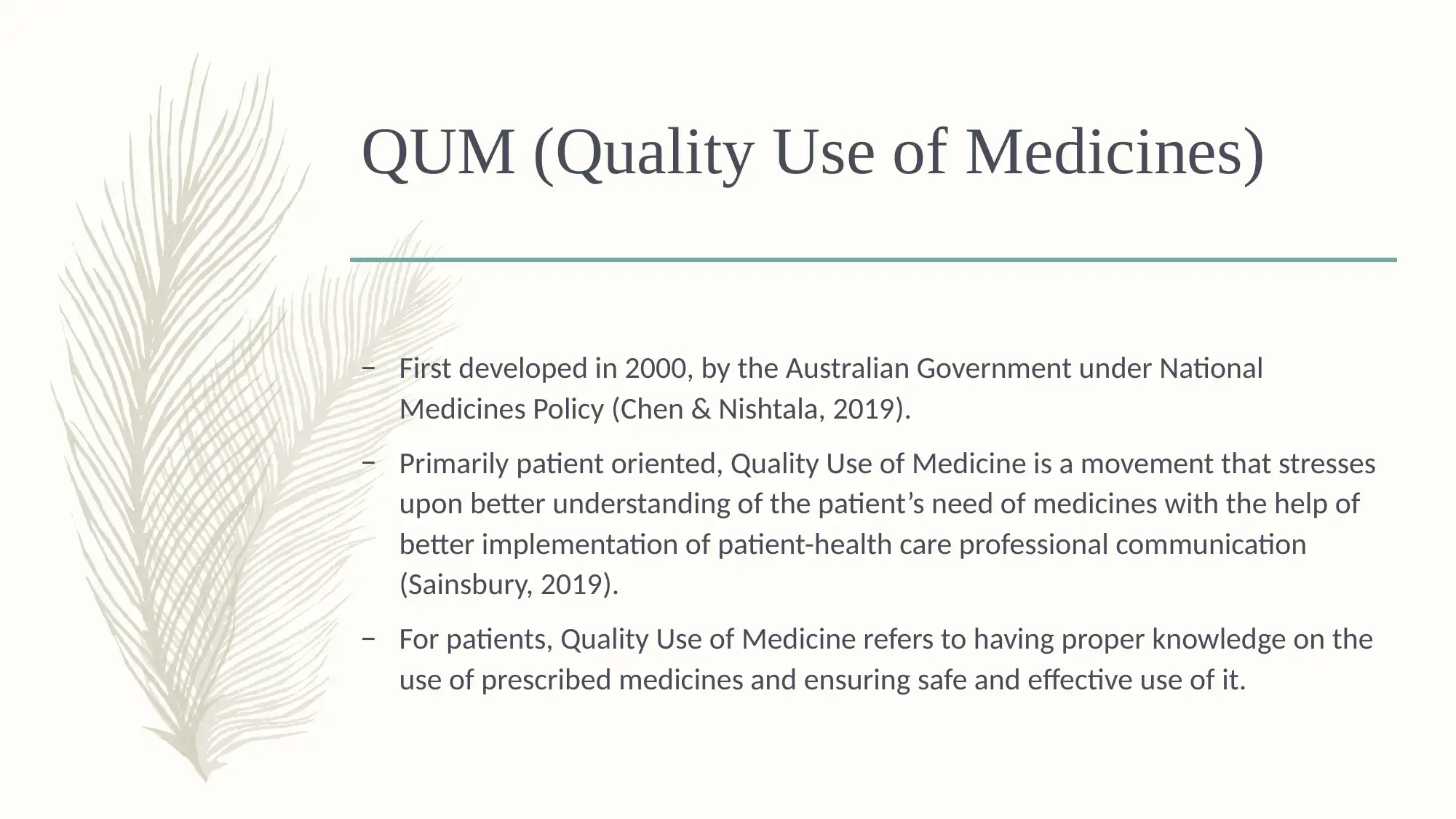
QUM (Quality Use of Medicines)
– First developed in 2000, by the Australian Government under National
Medicines Policy (Chen & Nishtala, 2019).
– Primarily patient oriented, Quality Use of Medicine is a movement that stresses
upon better understanding of the patient’s need of medicines with the help of
better implementation of patient-health care professional communication
(Sainsbury, 2019).
– For patients, Quality Use of Medicine refers to having proper knowledge on the
use of prescribed medicines and ensuring safe and effective use of it.
– First developed in 2000, by the Australian Government under National
Medicines Policy (Chen & Nishtala, 2019).
– Primarily patient oriented, Quality Use of Medicine is a movement that stresses
upon better understanding of the patient’s need of medicines with the help of
better implementation of patient-health care professional communication
(Sainsbury, 2019).
– For patients, Quality Use of Medicine refers to having proper knowledge on the
use of prescribed medicines and ensuring safe and effective use of it.
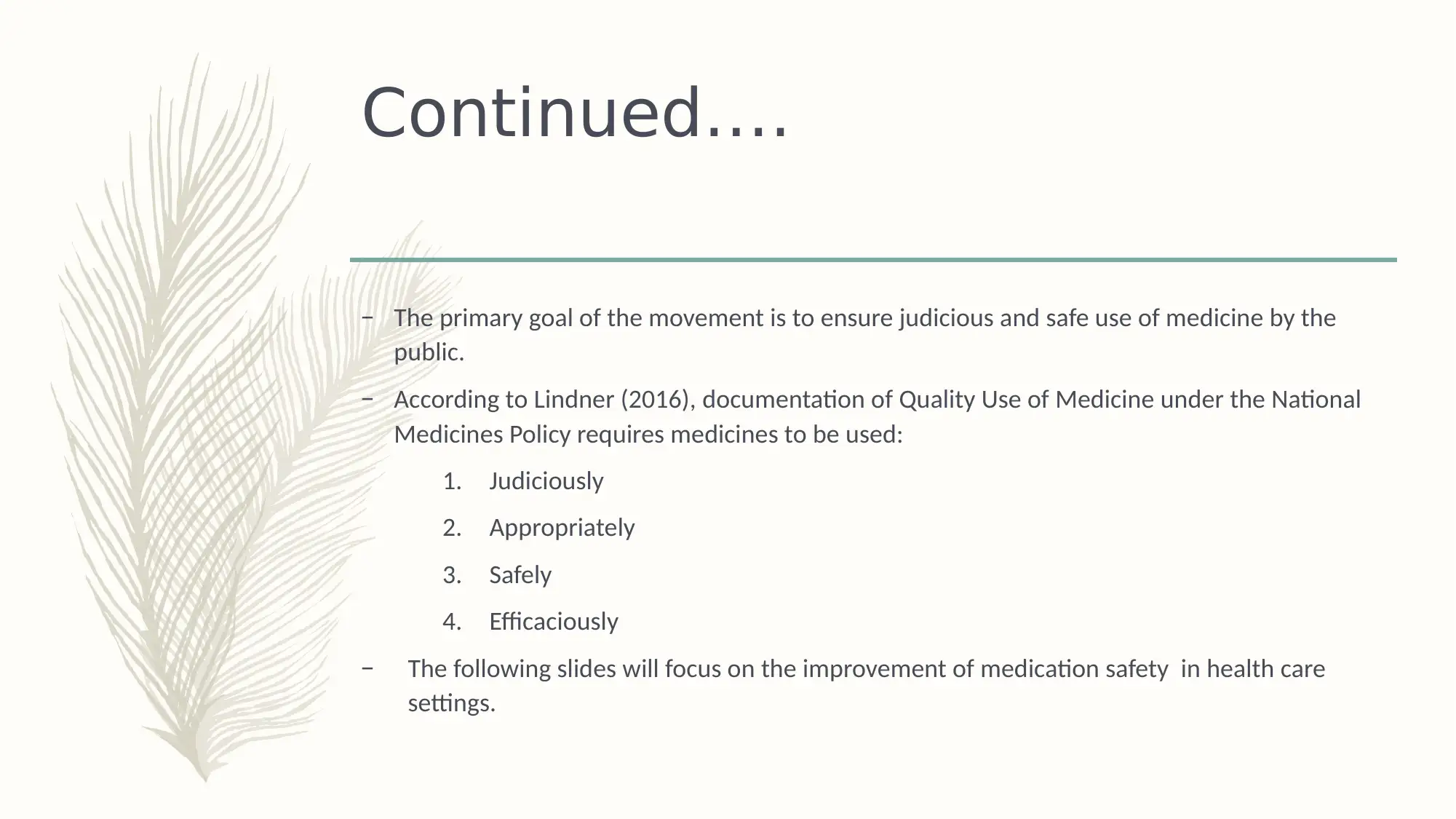
Continued….
– The primary goal of the movement is to ensure judicious and safe use of medicine by the
public.
– According to Lindner (2016), documentation of Quality Use of Medicine under the National
Medicines Policy requires medicines to be used:
1. Judiciously
2. Appropriately
3. Safely
4. Efficaciously
– The following slides will focus on the improvement of medication safety in health care
settings.
– The primary goal of the movement is to ensure judicious and safe use of medicine by the
public.
– According to Lindner (2016), documentation of Quality Use of Medicine under the National
Medicines Policy requires medicines to be used:
1. Judiciously
2. Appropriately
3. Safely
4. Efficaciously
– The following slides will focus on the improvement of medication safety in health care
settings.
⊘ This is a preview!⊘
Do you want full access?
Subscribe today to unlock all pages.

Trusted by 1+ million students worldwide

Understanding the Risk
Medication Errors
– The most common treatment method by health care providers is by the use of
medications and this effectively increases the incidence of medication errors
during health care interventions.
– Adverse events that follow medication errors during interventions are increased
spending of resources, mortality and morbidity issues (Tong et al., 2017).
– The risk of medication errors is highly avoidable.
– Common cause of medication errors include lack of patient’s knowledge on the
use of medications, poor and unsafe practices by the health care providers and
systems and improper transition of care of the patient (Latimer et al., 2017).
Medication Errors
– The most common treatment method by health care providers is by the use of
medications and this effectively increases the incidence of medication errors
during health care interventions.
– Adverse events that follow medication errors during interventions are increased
spending of resources, mortality and morbidity issues (Tong et al., 2017).
– The risk of medication errors is highly avoidable.
– Common cause of medication errors include lack of patient’s knowledge on the
use of medications, poor and unsafe practices by the health care providers and
systems and improper transition of care of the patient (Latimer et al., 2017).
Paraphrase This Document
Need a fresh take? Get an instant paraphrase of this document with our AI Paraphraser
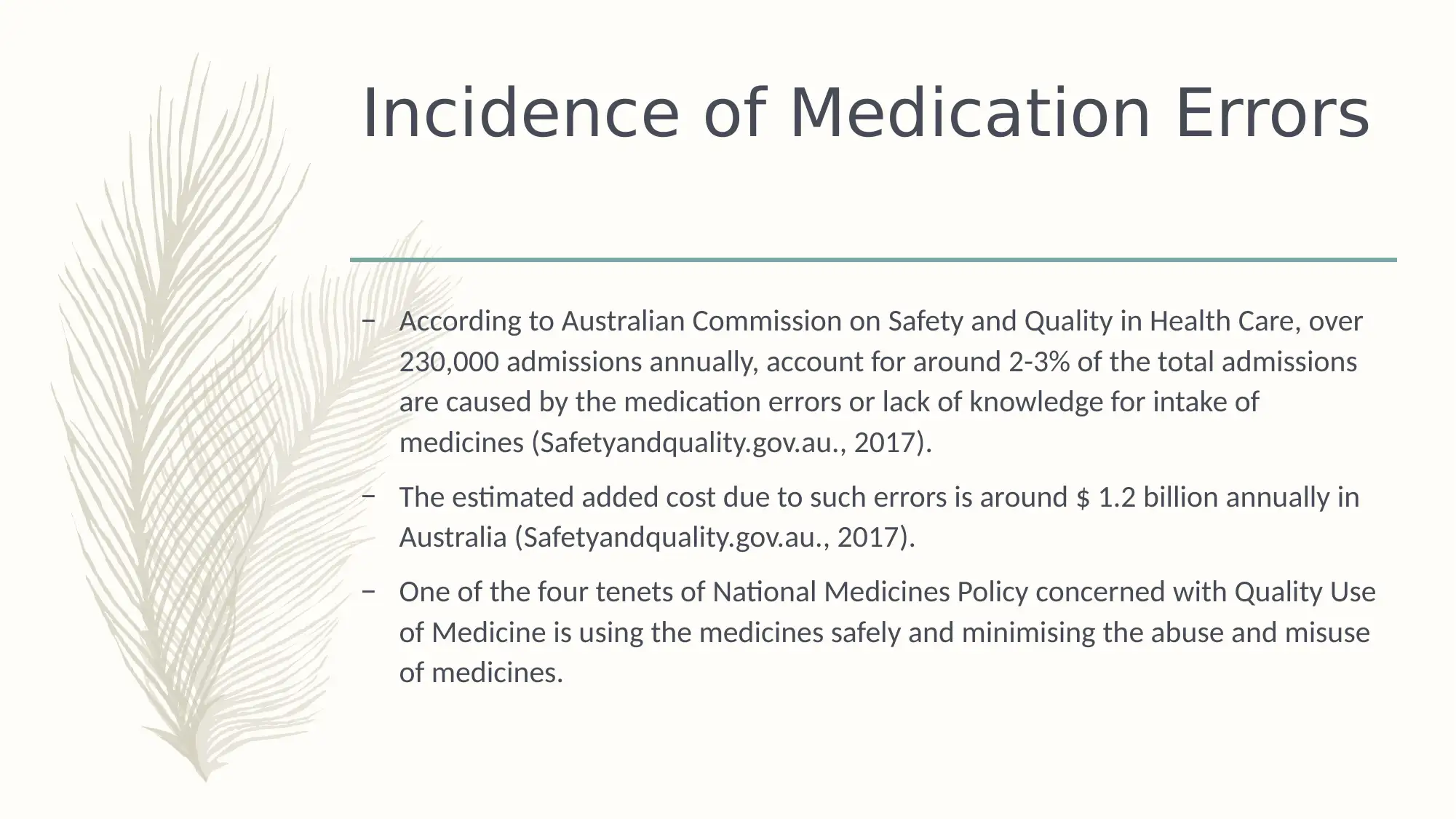
Incidence of Medication Errors
– According to Australian Commission on Safety and Quality in Health Care, over
230,000 admissions annually, account for around 2-3% of the total admissions
are caused by the medication errors or lack of knowledge for intake of
medicines (Safetyandquality.gov.au., 2017).
– The estimated added cost due to such errors is around $ 1.2 billion annually in
Australia (Safetyandquality.gov.au., 2017).
– One of the four tenets of National Medicines Policy concerned with Quality Use
of Medicine is using the medicines safely and minimising the abuse and misuse
of medicines.
– According to Australian Commission on Safety and Quality in Health Care, over
230,000 admissions annually, account for around 2-3% of the total admissions
are caused by the medication errors or lack of knowledge for intake of
medicines (Safetyandquality.gov.au., 2017).
– The estimated added cost due to such errors is around $ 1.2 billion annually in
Australia (Safetyandquality.gov.au., 2017).
– One of the four tenets of National Medicines Policy concerned with Quality Use
of Medicine is using the medicines safely and minimising the abuse and misuse
of medicines.
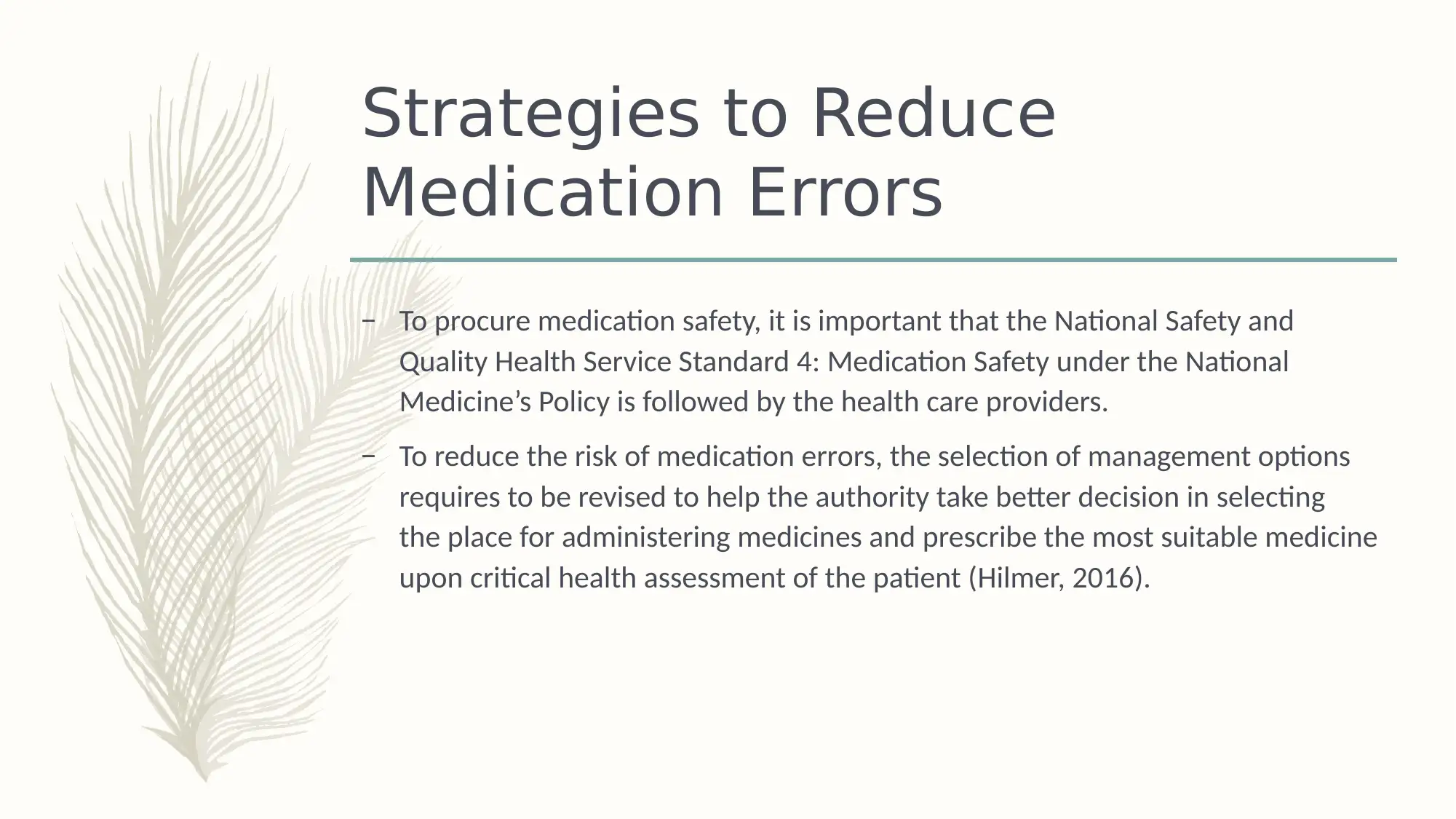
Strategies to Reduce
Medication Errors
– To procure medication safety, it is important that the National Safety and
Quality Health Service Standard 4: Medication Safety under the National
Medicine’s Policy is followed by the health care providers.
– To reduce the risk of medication errors, the selection of management options
requires to be revised to help the authority take better decision in selecting
the place for administering medicines and prescribe the most suitable medicine
upon critical health assessment of the patient (Hilmer, 2016).
Medication Errors
– To procure medication safety, it is important that the National Safety and
Quality Health Service Standard 4: Medication Safety under the National
Medicine’s Policy is followed by the health care providers.
– To reduce the risk of medication errors, the selection of management options
requires to be revised to help the authority take better decision in selecting
the place for administering medicines and prescribe the most suitable medicine
upon critical health assessment of the patient (Hilmer, 2016).
⊘ This is a preview!⊘
Do you want full access?
Subscribe today to unlock all pages.

Trusted by 1+ million students worldwide
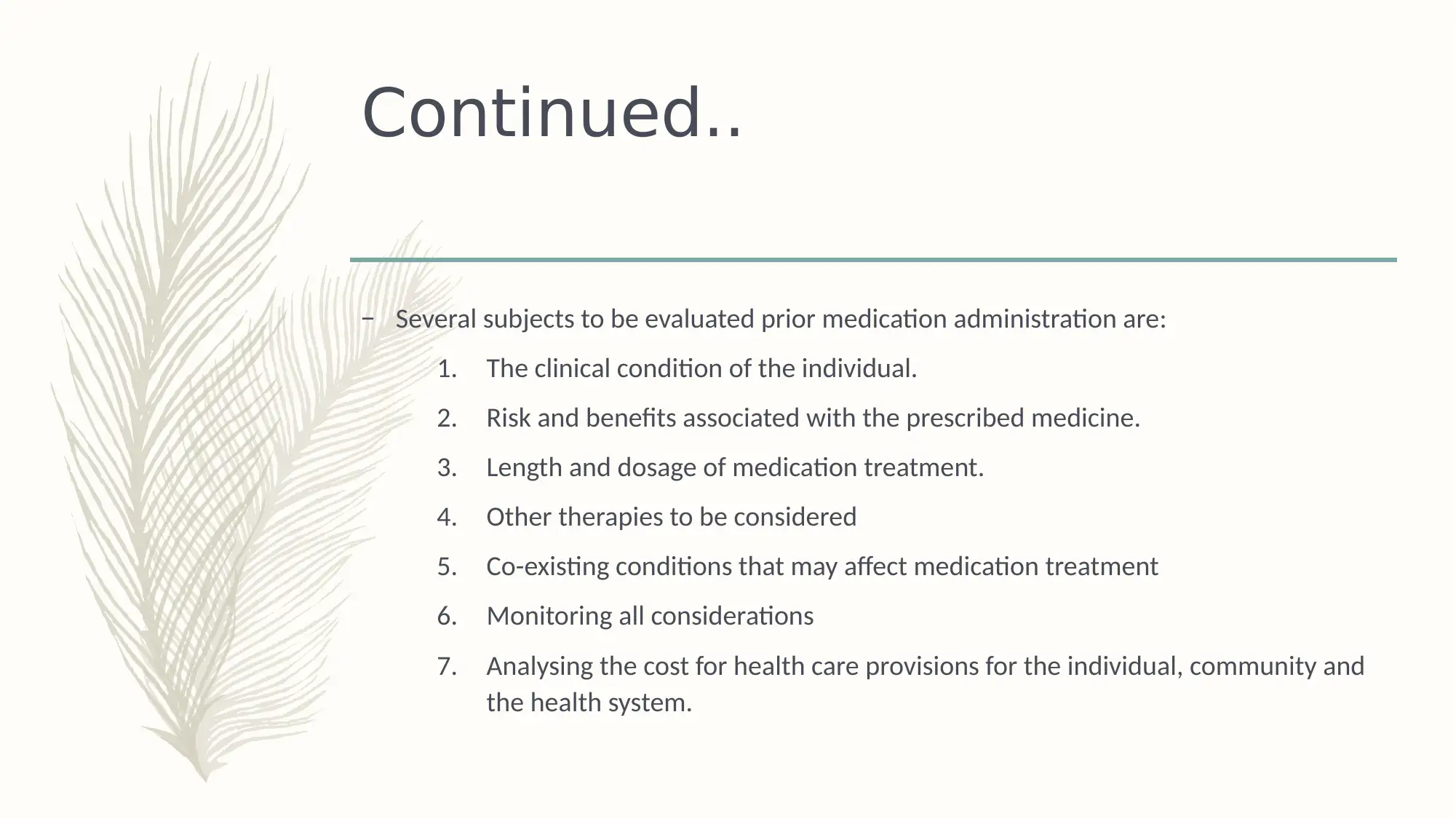
Continued..
– Several subjects to be evaluated prior medication administration are:
1. The clinical condition of the individual.
2. Risk and benefits associated with the prescribed medicine.
3. Length and dosage of medication treatment.
4. Other therapies to be considered
5. Co-existing conditions that may affect medication treatment
6. Monitoring all considerations
7. Analysing the cost for health care provisions for the individual, community and
the health system.
– Several subjects to be evaluated prior medication administration are:
1. The clinical condition of the individual.
2. Risk and benefits associated with the prescribed medicine.
3. Length and dosage of medication treatment.
4. Other therapies to be considered
5. Co-existing conditions that may affect medication treatment
6. Monitoring all considerations
7. Analysing the cost for health care provisions for the individual, community and
the health system.
Paraphrase This Document
Need a fresh take? Get an instant paraphrase of this document with our AI Paraphraser
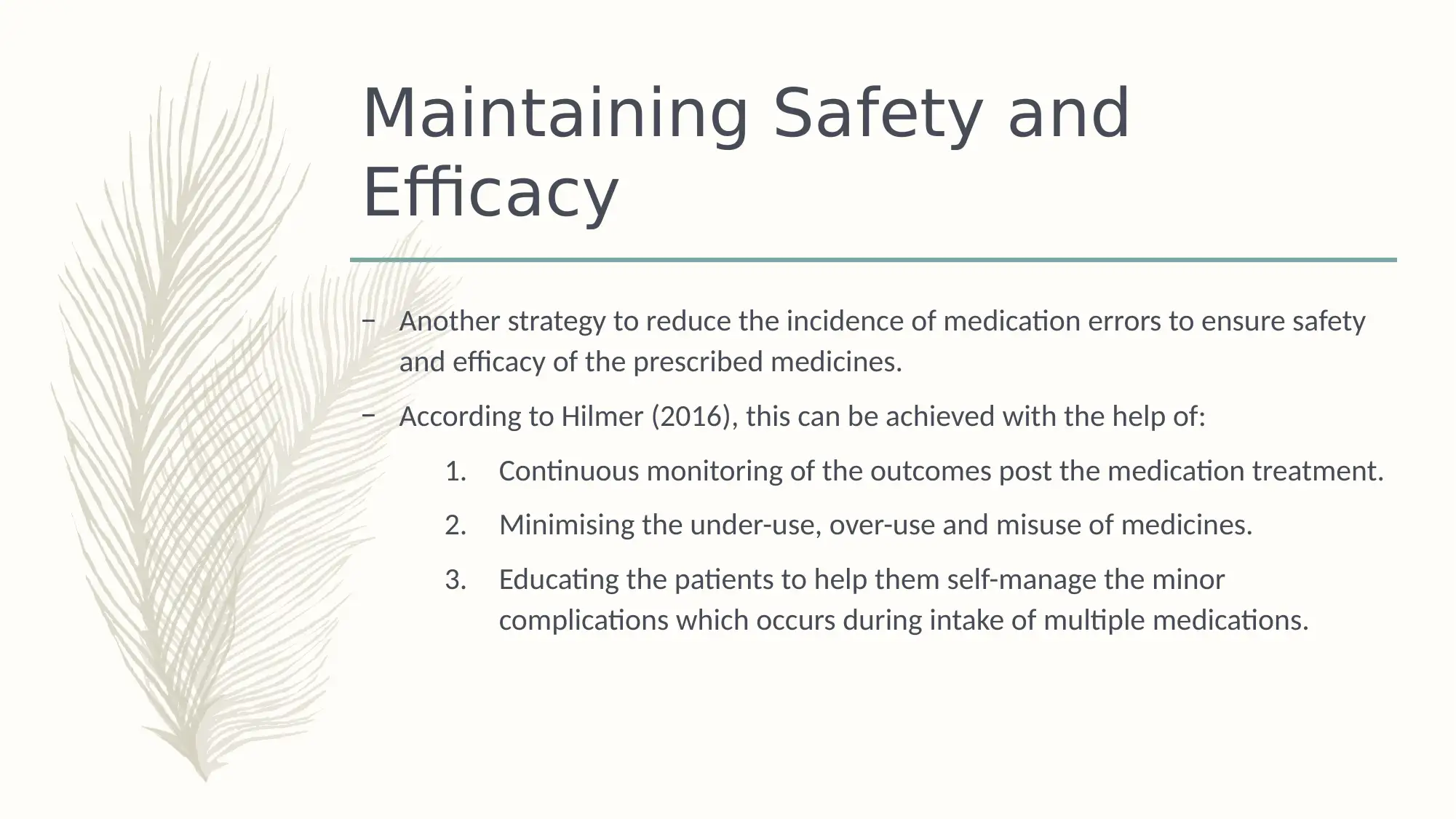
Maintaining Safety and
Efficacy
– Another strategy to reduce the incidence of medication errors to ensure safety
and efficacy of the prescribed medicines.
– According to Hilmer (2016), this can be achieved with the help of:
1. Continuous monitoring of the outcomes post the medication treatment.
2. Minimising the under-use, over-use and misuse of medicines.
3. Educating the patients to help them self-manage the minor
complications which occurs during intake of multiple medications.
Efficacy
– Another strategy to reduce the incidence of medication errors to ensure safety
and efficacy of the prescribed medicines.
– According to Hilmer (2016), this can be achieved with the help of:
1. Continuous monitoring of the outcomes post the medication treatment.
2. Minimising the under-use, over-use and misuse of medicines.
3. Educating the patients to help them self-manage the minor
complications which occurs during intake of multiple medications.
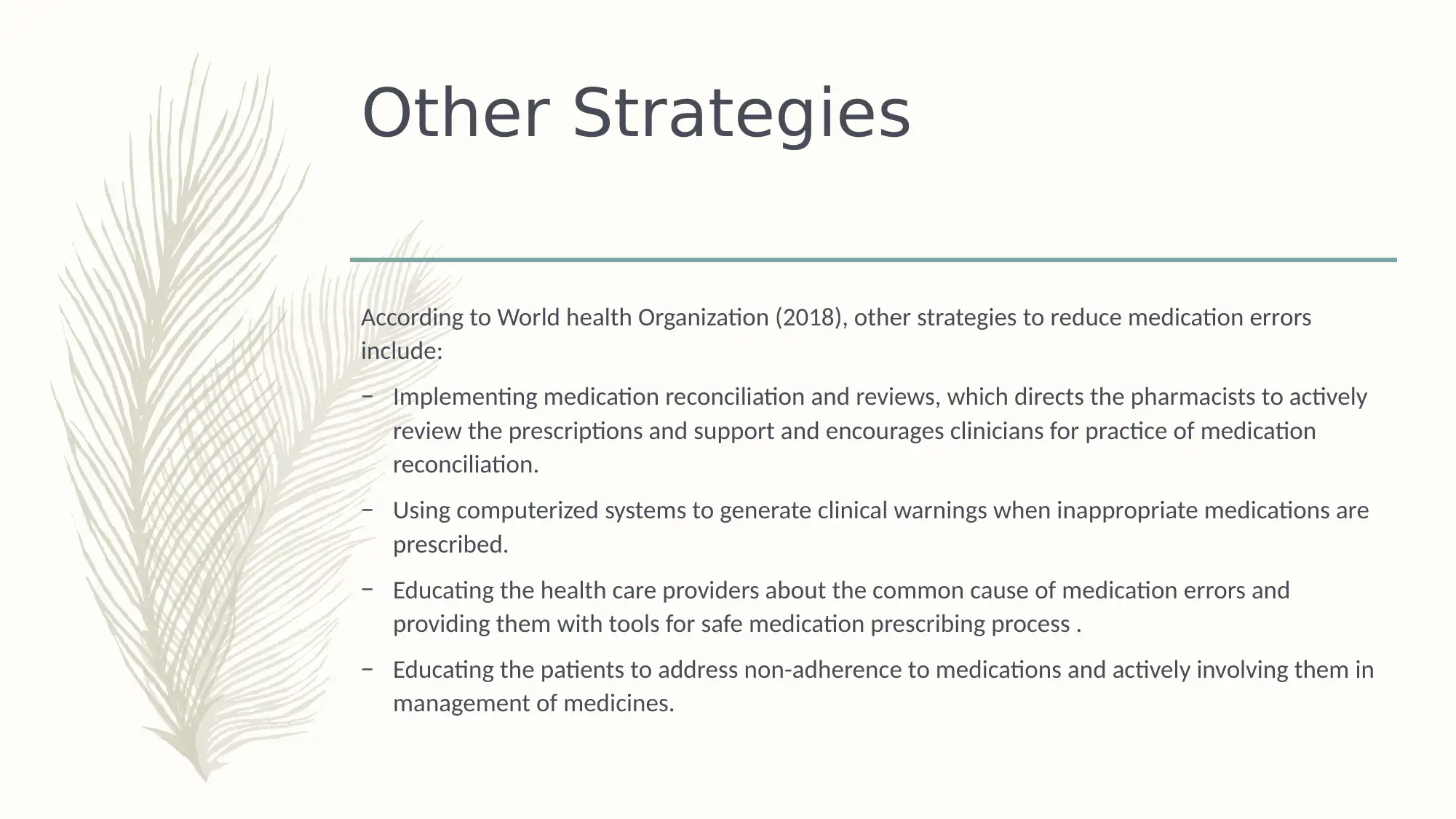
Other Strategies
According to World health Organization (2018), other strategies to reduce medication errors
include:
– Implementing medication reconciliation and reviews, which directs the pharmacists to actively
review the prescriptions and support and encourages clinicians for practice of medication
reconciliation.
– Using computerized systems to generate clinical warnings when inappropriate medications are
prescribed.
– Educating the health care providers about the common cause of medication errors and
providing them with tools for safe medication prescribing process .
– Educating the patients to address non-adherence to medications and actively involving them in
management of medicines.
According to World health Organization (2018), other strategies to reduce medication errors
include:
– Implementing medication reconciliation and reviews, which directs the pharmacists to actively
review the prescriptions and support and encourages clinicians for practice of medication
reconciliation.
– Using computerized systems to generate clinical warnings when inappropriate medications are
prescribed.
– Educating the health care providers about the common cause of medication errors and
providing them with tools for safe medication prescribing process .
– Educating the patients to address non-adherence to medications and actively involving them in
management of medicines.
⊘ This is a preview!⊘
Do you want full access?
Subscribe today to unlock all pages.

Trusted by 1+ million students worldwide

References
Bates, D. W., & Slight, S. P. (2014, August). Medication errors: what is their impact?. In Mayo Clinic Proceedings (Vol. 89,
No. 8, pp. 1027-1029). Elsevier.
Chen, T. F., & Nishtala, P. S. (2019). Pharmaceutical Care in Australia and New Zealand. In The Pharmacist Guide to
Implementing Pharmaceutical Care (pp. 173-182). Springer, Cham.
Hilmer, S. N. (2016). Strategies to reduce medication errors.
Latimer, S., Hewitt, J., Stanbrough, R., & McAndrew, R. (2017). Reducing medication errors: Teaching strategies that increase
nursing students' awareness of medication errors and their prevention.
Lindner, R. (2016). Be our guest: National medicines symposium to explore QUM challenges for pharmacists. Australian
Pharmacist, 35(2), 11.
Mekonnen, A. B., McLachlan, A. J., & Brien, J. A. E. (2016). Pharmacy‐led medication reconciliation programmes at hospital transitions: a
systematic review and meta‐analysis. Journal of clinical pharmacy and therapeutics, 41(2), 128-144.
Bates, D. W., & Slight, S. P. (2014, August). Medication errors: what is their impact?. In Mayo Clinic Proceedings (Vol. 89,
No. 8, pp. 1027-1029). Elsevier.
Chen, T. F., & Nishtala, P. S. (2019). Pharmaceutical Care in Australia and New Zealand. In The Pharmacist Guide to
Implementing Pharmaceutical Care (pp. 173-182). Springer, Cham.
Hilmer, S. N. (2016). Strategies to reduce medication errors.
Latimer, S., Hewitt, J., Stanbrough, R., & McAndrew, R. (2017). Reducing medication errors: Teaching strategies that increase
nursing students' awareness of medication errors and their prevention.
Lindner, R. (2016). Be our guest: National medicines symposium to explore QUM challenges for pharmacists. Australian
Pharmacist, 35(2), 11.
Mekonnen, A. B., McLachlan, A. J., & Brien, J. A. E. (2016). Pharmacy‐led medication reconciliation programmes at hospital transitions: a
systematic review and meta‐analysis. Journal of clinical pharmacy and therapeutics, 41(2), 128-144.
Paraphrase This Document
Need a fresh take? Get an instant paraphrase of this document with our AI Paraphraser
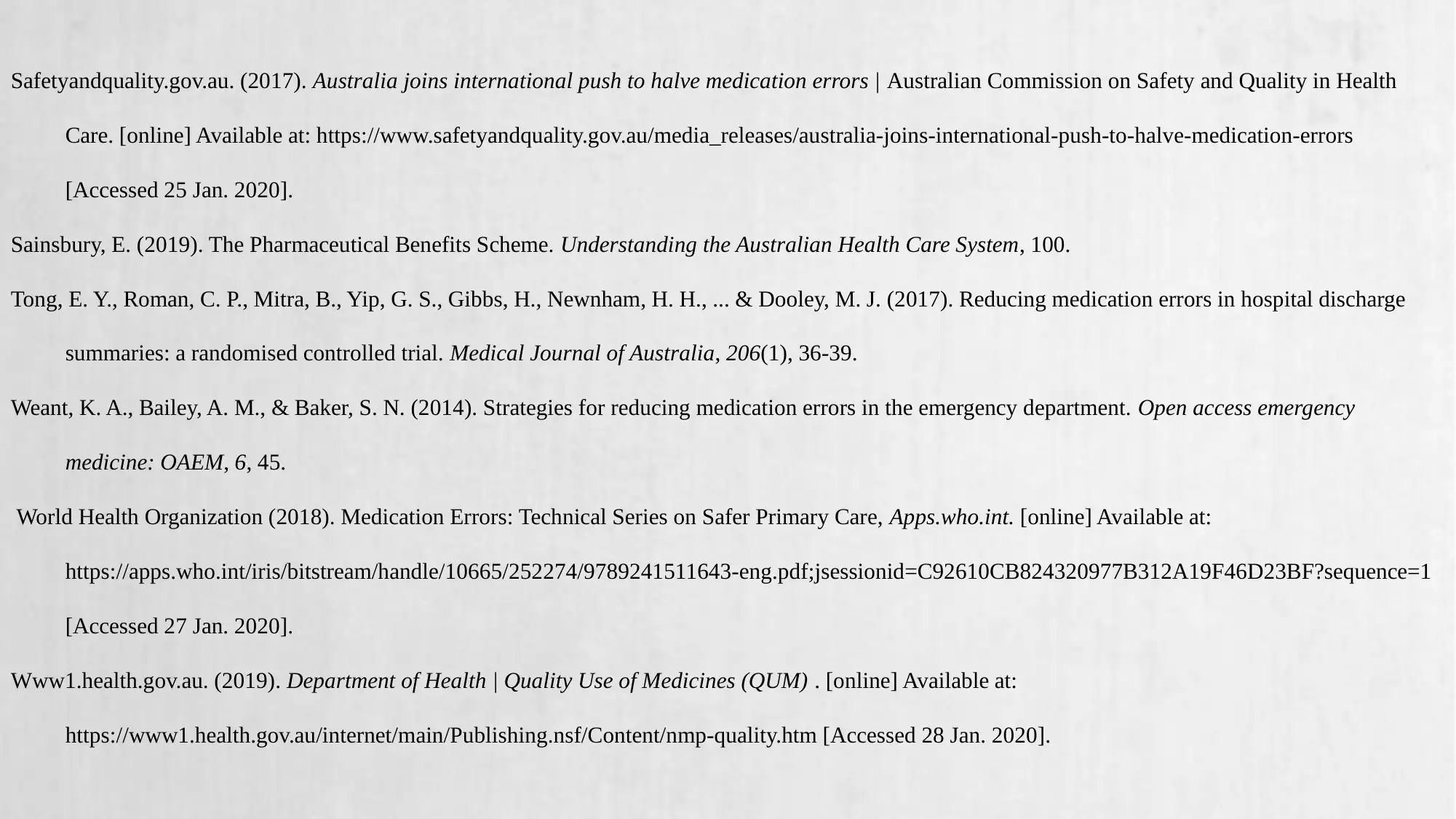
Safetyandquality.gov.au. (2017). Australia joins international push to halve medication errors | Australian Commission on Safety and Quality in Health
Care. [online] Available at: https://www.safetyandquality.gov.au/media_releases/australia-joins-international-push-to-halve-medication-errors
[Accessed 25 Jan. 2020].
Sainsbury, E. (2019). The Pharmaceutical Benefits Scheme. Understanding the Australian Health Care System, 100.
Tong, E. Y., Roman, C. P., Mitra, B., Yip, G. S., Gibbs, H., Newnham, H. H., ... & Dooley, M. J. (2017). Reducing medication errors in hospital discharge
summaries: a randomised controlled trial. Medical Journal of Australia, 206(1), 36-39.
Weant, K. A., Bailey, A. M., & Baker, S. N. (2014). Strategies for reducing medication errors in the emergency department. Open access emergency
medicine: OAEM, 6, 45.
World Health Organization (2018). Medication Errors: Technical Series on Safer Primary Care, Apps.who.int. [online] Available at:
https://apps.who.int/iris/bitstream/handle/10665/252274/9789241511643-eng.pdf;jsessionid=C92610CB824320977B312A19F46D23BF?sequence=1
[Accessed 27 Jan. 2020].
Www1.health.gov.au. (2019). Department of Health | Quality Use of Medicines (QUM) . [online] Available at:
https://www1.health.gov.au/internet/main/Publishing.nsf/Content/nmp-quality.htm [Accessed 28 Jan. 2020].
Care. [online] Available at: https://www.safetyandquality.gov.au/media_releases/australia-joins-international-push-to-halve-medication-errors
[Accessed 25 Jan. 2020].
Sainsbury, E. (2019). The Pharmaceutical Benefits Scheme. Understanding the Australian Health Care System, 100.
Tong, E. Y., Roman, C. P., Mitra, B., Yip, G. S., Gibbs, H., Newnham, H. H., ... & Dooley, M. J. (2017). Reducing medication errors in hospital discharge
summaries: a randomised controlled trial. Medical Journal of Australia, 206(1), 36-39.
Weant, K. A., Bailey, A. M., & Baker, S. N. (2014). Strategies for reducing medication errors in the emergency department. Open access emergency
medicine: OAEM, 6, 45.
World Health Organization (2018). Medication Errors: Technical Series on Safer Primary Care, Apps.who.int. [online] Available at:
https://apps.who.int/iris/bitstream/handle/10665/252274/9789241511643-eng.pdf;jsessionid=C92610CB824320977B312A19F46D23BF?sequence=1
[Accessed 27 Jan. 2020].
Www1.health.gov.au. (2019). Department of Health | Quality Use of Medicines (QUM) . [online] Available at:
https://www1.health.gov.au/internet/main/Publishing.nsf/Content/nmp-quality.htm [Accessed 28 Jan. 2020].
1 out of 11
Related Documents
Your All-in-One AI-Powered Toolkit for Academic Success.
+13062052269
info@desklib.com
Available 24*7 on WhatsApp / Email
![[object Object]](/_next/static/media/star-bottom.7253800d.svg)
Unlock your academic potential
Copyright © 2020–2025 A2Z Services. All Rights Reserved. Developed and managed by ZUCOL.





